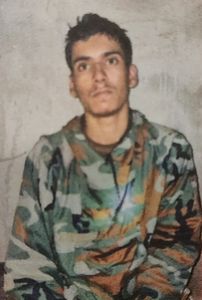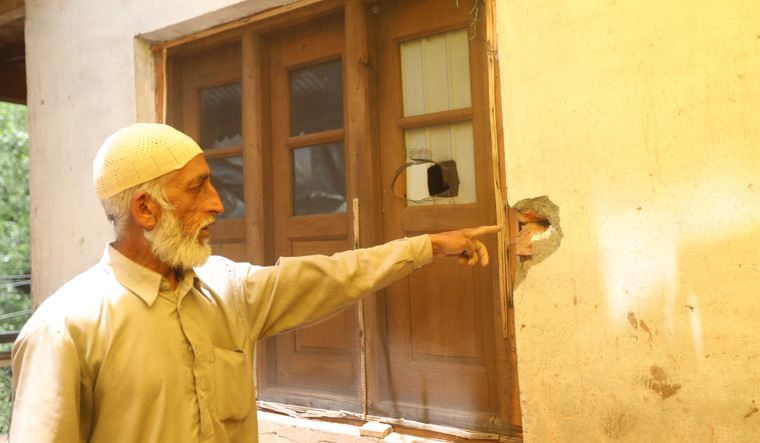On September 27, Ali Babar Patra became the first Pakistani militant to be caught in India since both countries agreed to uphold the 2003 ceasefire agreement in February. The Indian Army caught Patra and five others sneaking across the Line of Control in the Uri sector on September 18. While four of them turned back, two—Patra and Atiq-ur-Rehman, alias Qari Anas—snuck in. After nine days, the Army traced them down to the Salamabad Nallah (rivulet) in Uri. When challenged, Anas shot a soldier; he was shot down and Patra was captured alive.
“I am 18 and a resident of Dipalpur, district Okara, Punjab, Pakistan,” Patra said in a clip the Army released three days later. “My father was Muhammad Lateef and my mother Shamima Bibi. My father died in 2014. After that, I quit school and worked in a garment factory in Sialkot. [That is] where I met Anas, who worked for the LeT (Lashkar-e-Taiba). As I needed money, I went with him. He gave me 020,000 and said he would give me 030,000 more later.”
He said he had undergone weapons training with eight others at camp Khyber Delihabibullah. “On September 18, Anas and I cut the fence (anti-infiltration fence at the LoC) at night and crossed in,” he said. “Four others retreated after the Army launched an operation.”
He said the Army had treated him well. “They gave me food and tea and allowed me to offer namaz (prayer),” he said. “When I was being taken away in a vehicle, I saw a lot of rush in the markets and also heard azaan (call to prayer).” He also said he hoped to reunite with his mother, a widow, soon.
A day after Patra was caught, Lieutenant General D.P. Pandey, general officer commanding of the Srinagar-based 15 Corps (Chinar Corps), visited Uri and said the troops were prepared to deal with any mischief along the border.
Since February, when both countries agreed to cease fire, villagers close to the LoC have enjoyed a semblance of normalcy. Muhammad Subhan Dar, sarpanch of Hathlanga, a village in Uri, said the ceasefire had eased their lives. “When there is firing and shelling, people and cattle die and houses are damaged,” he said. “Some years ago, my daughter’s arm had to be amputated after a bullet hit her; my neighbour Ghulam Muhammad was killed when shells hit his house. We need concrete bunkers close to our homes. Ours is a zero-line village (right on the LoC). How can we leave our homes to take shelter in bunkers far away when there is shelling?”
Five kilometres away at Telawadi village, Muhammad Yaqoob Qali said the ceasefire had put their minds at rest. “People work in the fields, graze cattle in the mountains and the children attend school without fear,” he said.
Some villagers like Parvez Ahmed, however, have relocated with their families to lead a normal life, he said. “He (Ahmed) is a soldier in the Jammu and Kashmir Light Infantry,” Qali said. “He is posted in Kerala and has taken his family along. I look after his house.”
In neighbouring Balkote, Bashir Ahmed said that, before the ceasefire, they would run for their lives whenever they heard a siren. “People would hide under a rock or a tree,” he said. “Shepherds would abandon their herds and look for cover. [But] now the cattle graze well, and the quality and quantity of milk has also improved.”
Nishada Parveen, a member of the Block Developmental Council at Teetwal in Kupwara, said that people were enjoying weddings, night gatherings and folk music without fear after several years. Aijaz Ahmad Khan, a member of the District Development Council of Tulail in Bandipore, said there had been relative peace since February. “Due to the ceasefire, we are focusing on developmental activities,” he said. “Some projects are under the roads and buildings department, and some are under the Pradhan Mantri Gram Sadak Yojana. We are also working on a sports stadium.”
Khursheed Ahmed Khan, a contractor, said he was building 13 community bunkers in Silkote (the closest village to the LoC in Uri), three in Mothun and four in Churanda. He said each bunker would be eight feet high, 31ft long and 17ft wide, with ventilators. He added that it had become much easier to find labourers following the ceasefire.
The peace in the region might not hold for long, though. The recent rise in infiltration, including in the Muslim-majority districts of Rajouri and Poonch, could put the ceasefire under strain. The number of infiltration attempts has grown with the Taliban offensive in Afghanistan, which began in May. About 20 foreign militants snuck in in four infiltrations in June. Unlike local militants, foreign militants are tougher and better equipped. Since January, security forces have killed 113 militants in Jammu and Kashmir, most of them locals. Till July this year, eight foreign militants were killed. Another 13 have been killed in infiltration attempts since.
Security forces believe that the LeT and Jaish-e-Mohammad are likely to increase their activity in Kashmir. Major General Virendra Vats, general officer commanding of the 19 Infantry Division of Uri, said that the Army had noticed militant movement at launchpads across the LoC. He said five of seven militants neutralised in the nine-day operation, which started on September 18, were killed in Hathlanga. He said the Army recovered seven AK series rifles, nine pistols and 80 grenades from the slain militants.
Security officials believe the JeM, which practises the Deobandi branch of Islam like the Afghan Taliban, has been emboldened after the Taliban took over Afghanistan. The JeM was behind the Pulwama attack of 2019, which claimed 40 Central Reserve Police Force men.
With the Indian Army locked in a battle of nerves with China in Ladakh, Pakistan would feel more confident about launching attacks along the LoC.
In view of this rising threat, though, the Army has increased its strength along the LoC. It is also strengthening its defence with a smart fence to beat infiltration.
It remains to be seen whether the peace that the border villagers enjoyed was just the calm before the storm.




